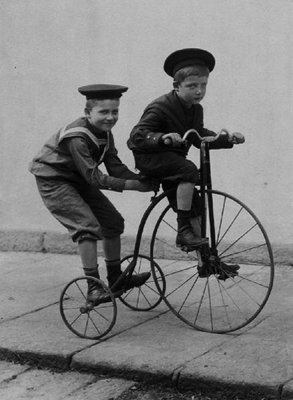
1817 – The first practical bicycle
The first verifable claim for a practical bicycle was made by German Karl von Drais, a civil servant. Drais invented the Laufmaschine (German for running machine) and patented the design in 1818. Commonly called draisine, the steerable, wooden, human-propelled machine was the first commercially successful bicycle.
1860s – Bicycles get pedals
The bicycle received an upgrade when pedals were added to it. This made it easier for people to propel the vehicle. Ernest Michaux and Pierre Lallement invented a vehicle known as the velocipede, also dubbed the boneshaker due to the rough ride it offered without brakes.
1870 – The high wheel cycle
The penny-farthing was the first machine to be called a bicycle. Extremely popular in the 1870 and 80s, it got its name from the British coins penny and farthing – penny indicating the large font wheel, and farthing depicting the tiny back wheel. It allowed users to ride faster. Frenchman Eugene Meyer was the first to invent it in 1869.
1885 – ‘Safety’ first
Apart from the speed, the penny-farthing was a risky ride for many due to its high front wheel and seating. Hence, in 1885, Englishman John Kemp Startley came up with the ‘rover safety bicycle’ which had similar sized wheels and a chain drive. This was followed by developments in brakes and tires. The rover is regarded as the first modern bicycle. It also started Golden Age of bicycles.
1888 – The ride got comfortable
John Boyd Dunlop, a Scottish inventor created the pneumatic tyre, an inflatable tyre filled with air. This made cycling far more comfortable than before. It also made the cycle much lighter in weight.
1890 – In tandem
The first publicised bicycle for two was created by Danish inventor Mikael Pederson. Tandem bicycle or twin bicycle is a bike meant for two people. The term ‘tandem’ refers to the seating arrangement for riders, one behind the other.
1890s – Advent of the electric bicycle
Ogden Bolton Jr. was issued a U.S. Patent for a battery-powered bicycle without gear. The motor could draw up to 100 amperes of power from a 10-volt battery.
1900s – The rise and fall
Bicycles rose in popularity and came to be mass produced. While the basic design remained similar to the safety cycle, several upgrades were made. Bicycles were touted to have had a direct influence on the introduction of the automobiles. Soon, the popularity of bicycles began to wane. However, in the 1960s, many started seeing the bicycle as a non-polluting and non-congesting means of transportation. Some even began using the bicycle for recreation.
1970s – BMX and Mountain Bikes
BMX (bicycle motocross) bikes became popular in the U.S. around the 1970s. These are off-road bicycles used for stunt riding and racing. Today, BMX races have grown into an international sport.
Mountain bikes became popular with their mass production in 1981. These bikes are meant for off-pavement riding on a variety of surfaces.
2000s – Hybrid and commuter cycles
In the last two decades, several designs modifications have been made to the bicycle. Since number of people using the bicycle for commuting, casual and recreational purposes has gone up, manufactures are coming out with hybrid bicycles which combine elements of bike racing and mountain bikes.
There have also been attempts at mass producing solar-powered bicycles which will derive power from the sun’s rays and help riders travel without having to pedal for some distance at least.
Picture Credit : Google




